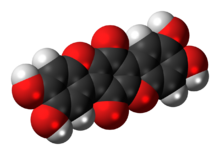Chemistry:Thelephoric acid
From HandWiki

| |

| |
| Names | |
|---|---|
| Preferred IUPAC name
2,3,8,9-Tetrahydroxybenzo[1,2-b:4,5-b′]bis([1]benzofuran)-6,12-dione | |
| Identifiers | |
3D model (JSmol)
|
|
| ChEBI | |
| ChEMBL | |
| ChemSpider | |
PubChem CID
|
|
| |
| |
| Properties | |
| C18H8O8 | |
| Molar mass | 352.254 g·mol−1 |
Except where otherwise noted, data are given for materials in their standard state (at 25 °C [77 °F], 100 kPa). | |
| Infobox references | |
Tracking categories (test):
Thelephoric acid is a terphenylquinone pigment that is found in several fungi, such as Omphalotus subilludens[1] and Polyozellus multiplex.[2] Thelephoric acid has been shown to inhibit prolyl endopeptidase, an enzyme that has a role in processing proteins (specifically, amyloid precursor protein) in Alzheimer's disease. Chemicals that inhibit prolyl endopeptidase have attracted research interest due to their potential therapeutic effects.[3][4] It is derived from atromentin, and its precursor can be from cyclovariegatin. Fragmentation patterns have suggested that polymers of thelephoric acid exists.
References
- ↑ "Occurrence of atromentin and thelephoric acid in cultures of Clitocybe subilludens". Journal of Pharmaceutical Sciences 60 (11): 1727–29. 1971. doi:10.1002/jps.2600601134. PMID 4332377.
- ↑ "Thelephoric acid and kynapcin-9 in mushroom Polyozellus multiflex inhibit prolyl endopeptidase in vitro". Journal of Microbiology and Biotechnology 9 (6): 798–803. 1999.
- ↑ "Polyozellin, a new inhibitor of prolyl endopeptidase from Polyozellus multiplex". The Journal of Antibiotics 50 (9): 773–77. 1997. doi:10.7164/antibiotics.50.773. PMID 9360624.
- ↑ "Potential anti-angiogenesis effects of p-terphenyl compounds from Polyozellus multiplex". Journal of Natural Products 77 (4): 963–8. 2014. doi:10.1021/np401046z. PMID 24601669.
 |

